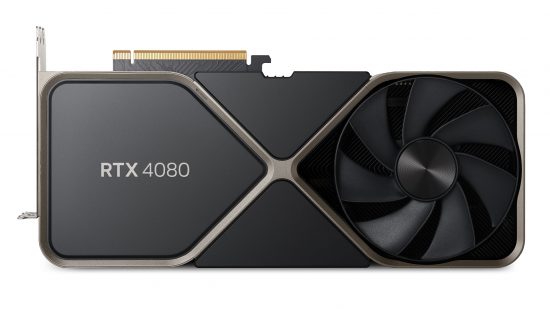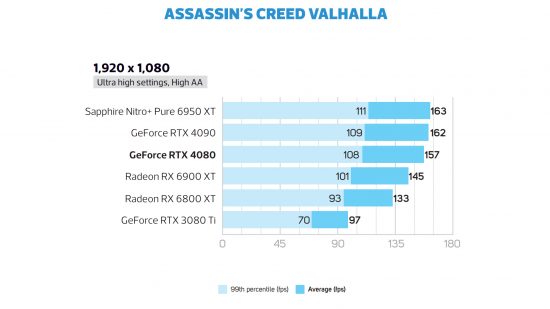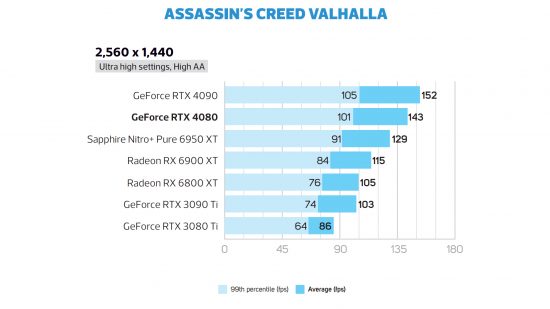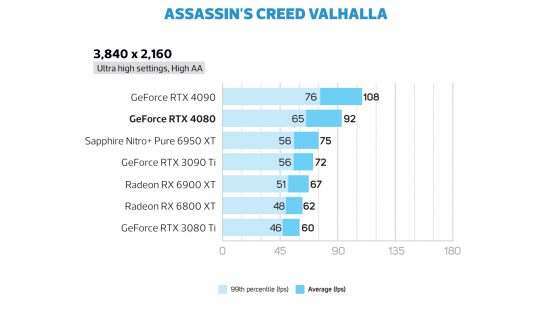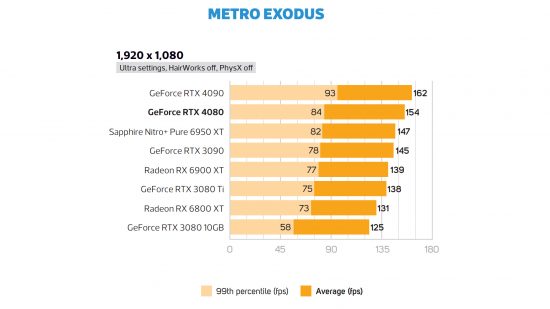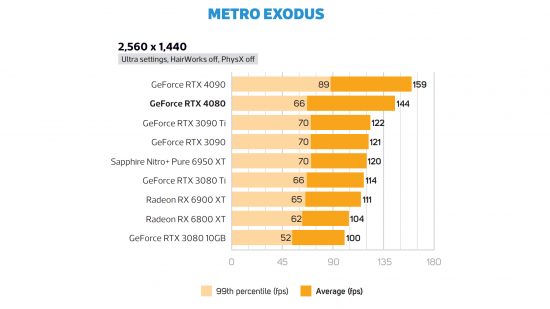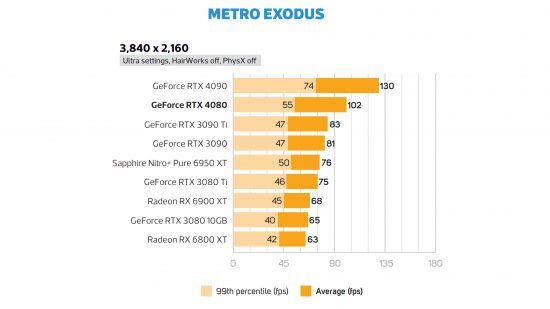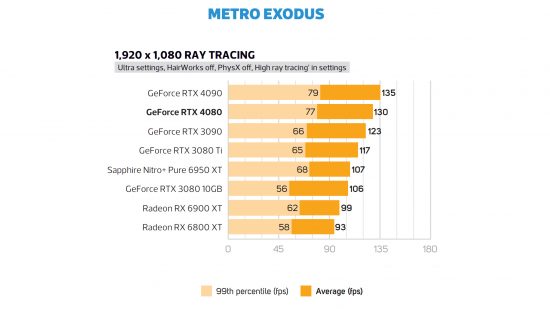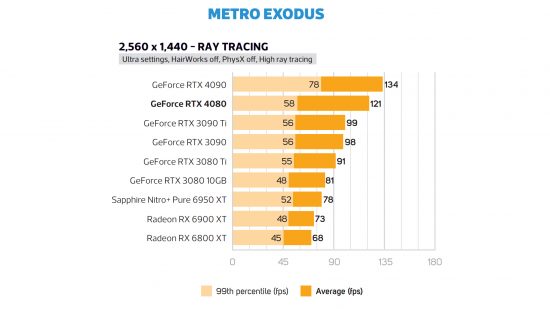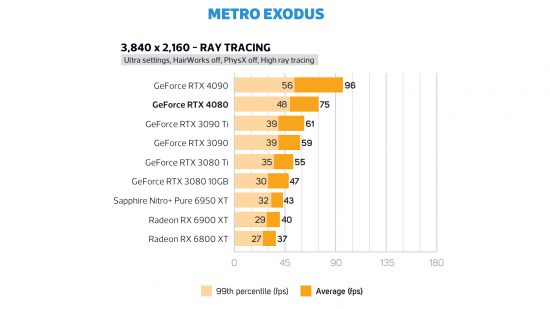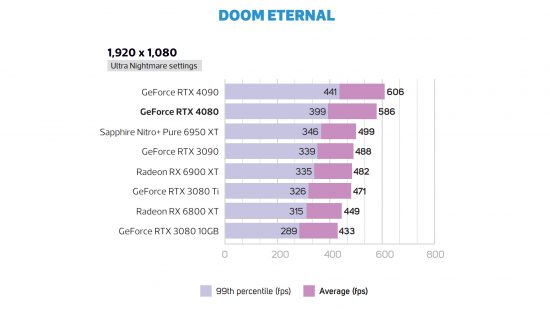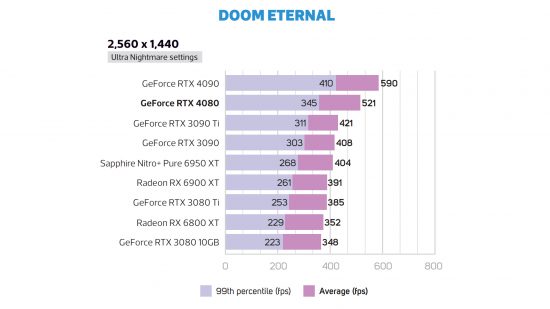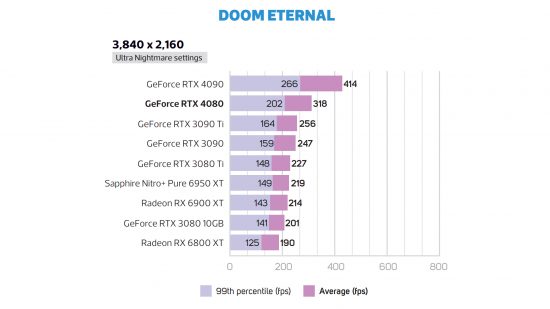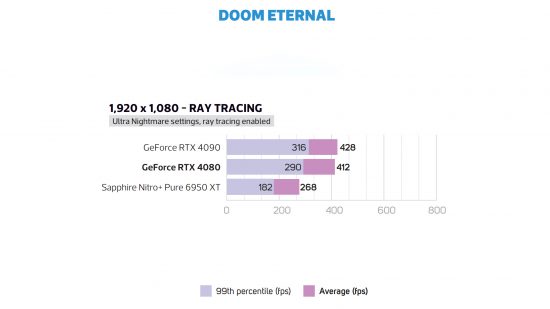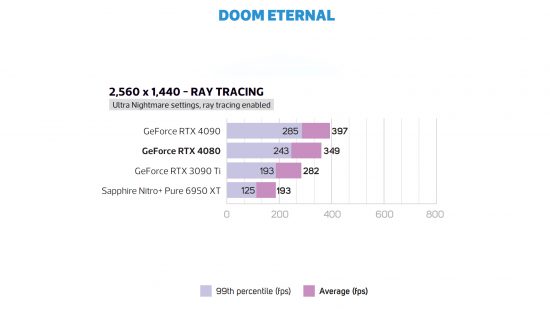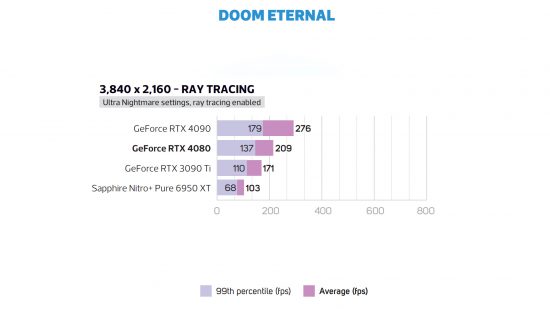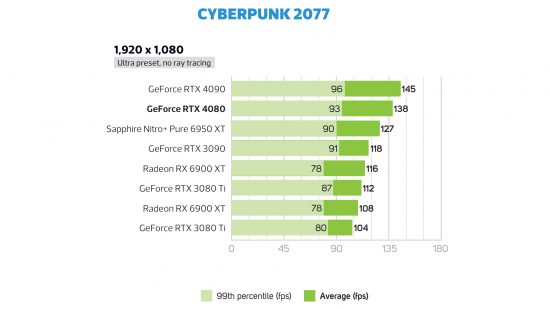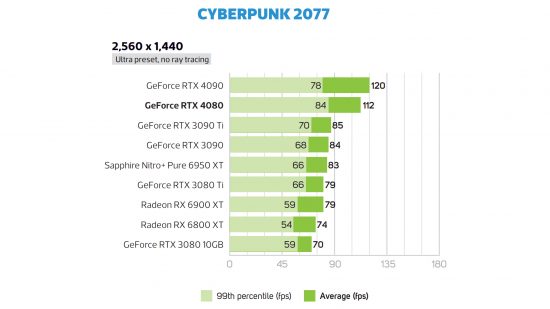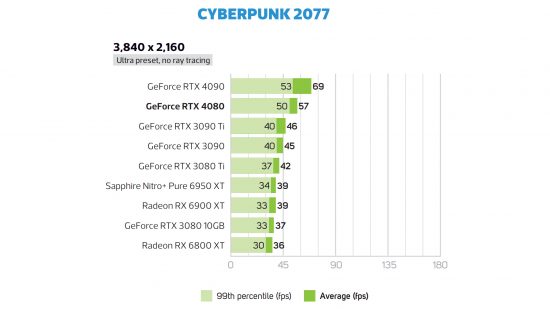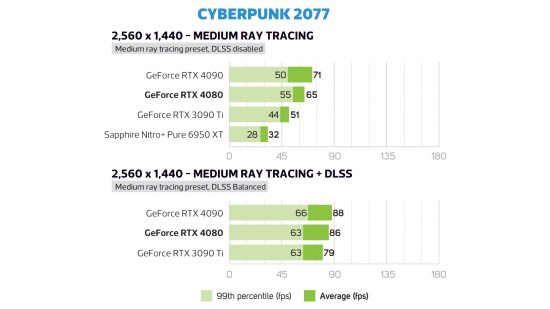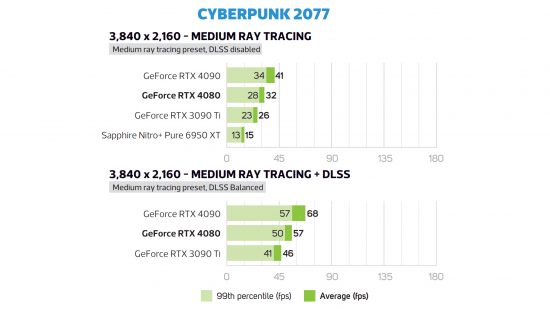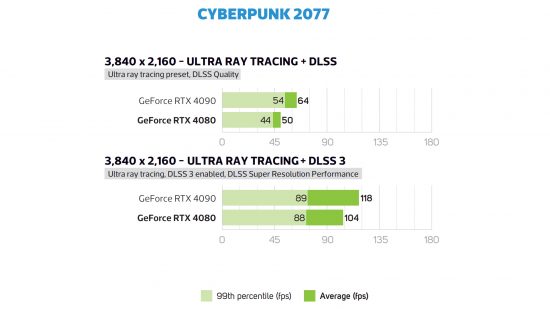Our Verdict
69%Surprisingly quick performance from Nvidia’s smaller Ada GPU. It’s second only to the mighty RTX 4090, but it’s also hugely overpriced.
We’re writing this review the day after the Nvidia GeForce GTX 4080 launched, by which time we’d usually expect every retailer to be out of stock, while a bunch of seriously overpriced cards were appearing on eBay. Not this time, though.
At Custom PC, we’ve been reviewing the latest gaming GPUs since 2003, and we run a number of grueling benchmarks in order to gauge performance. Our game tests include measuring the frame rate in Cyberpunk 2077, Doom Eternal, and Metro Exodus, all with and without ray tracing, and we also test with Assassin’s Creed Valhalla. For more information, please read our How we test page.
We don’t yet know whether the stock situation is a result of plentiful supply, or over-ambitious pricing from Nvidia, but it certainly makes a change. Even so, the price of $1,199 USD / £1,199 GBP is massively higher than the $699 (£649) launch price of the GeForce RTX 3080 just two years ago.
It’s a new approach to pricing from Nvidia, where both the top-end flagship card and its nearest sibling cost well over a grand at launch. It remains to be seen whether it will pay off, but the RTX 4080 has its work cut out if Nvidia is going to justify that whopping price. Despite being closer to the flagship product’s price than previous 80-series Nvidia GPUs, the RTX 4080 has a substantially lesser spec on paper.
Nvidia GeForce RTX 4080 AD103 GPU
Rather than being based on the same AD102 GPU as the RTX 4090, but with a few parts disabled, the RTX 4080 is instead based on a whole new GPU called the AD103. It’s based on the same Ada Lovelace architecture as AD102, but it’s much smaller. AD103 has a 379 mm² die area, but this still packs in 45.9 billion transistors, thanks to TSMC’s 4N manufacturing process.
As a point of comparison, the top-end Ampere GA102 GPU had a much larger area of 628.4 mm², but ‘only’ packed in 28.3 billion transistors. AD103 is still a complex chip, then, even if it doesn’t have anywhere near the 76.3 billion transistors found in the AD102 chip.
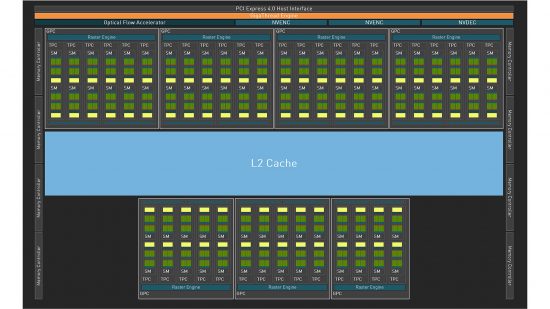
A fully-enabled AD103 chip has six Graphics Processing Clusters (GPCs) with 12 Streaming Multiprocessors (SMs) each, and another GPC that contains a further eight SMs. If all the parts are enabled you get a total of 10,240 stream processors / CUDA cores, but the RTX 4080 disables four of the chip’s SMs, giving you 9,728.
That’s a lot of shading power, and it means there’s a bit of headroom for a fully-enabled ‘RTX 4080 Ti’ card or similar at a later date. However, on paper it pales in comparison to the 16,384 CUDA cores found in the RTX 4090. Likewise, the RTX 4080 has 76 3rd-gen RT cores for ray tracing, but the RTX 4090 has much more art 128.
You also get 8 GB less memory, and the RTX 4080’s 16 GB of GDDR6X memory is only attached to a 256-bit memory interface, compared to the 384-bit interface on the 4090. In this case, though, the memory is quicker than that of the RTX 4090, running at 1400 MHz (22.4 GHz effective). This gives you a still-potent total memory bandwidth of 716.8GB/sec, although that’s still much narrower than the RTX 4090’s memory bandwidth, which breaks the 1TB/sec barrier.
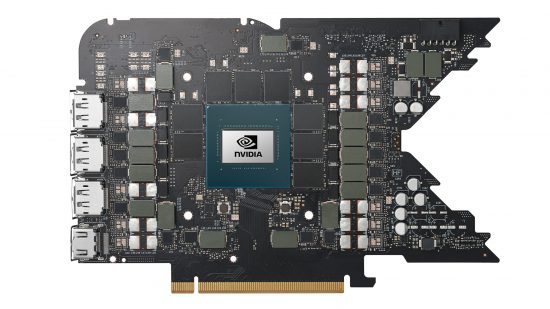
The RTX 4080 can potentially compensate for that comparative lack of memory bandwidth with its whopping cache allocation, though. It’s equipped with 65,536 KB of L2 cache, compared with just 6,144 KB on the GeForce RTX 3090 Ti.
It’s also clocked much higher than its Ampere-based predecessors, with a base clock of 2205 MHz and a boost clock of 2505MHz. However, thanks to the huge cooler supplied with the Founders Edition (which is identical to the cooler on the RTX 4090 FE), our RTX 4080 was regularly boosting to a peak of 2805 MHz during game testing. Comparatively, the RTX 4090 was only boosting to around 2735 MHz.
On paper, then, the RTX 4080 looks set to be a much lesser chip than the RTX 4090, but how does that bear out in actual game benchmarks?
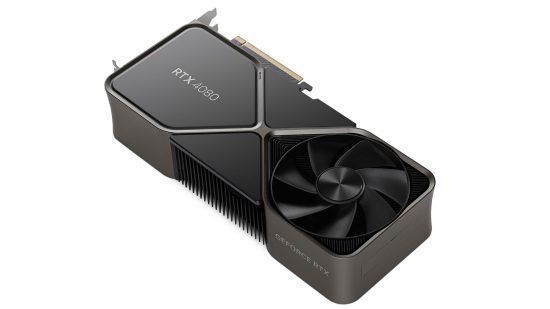
Nvidia GeForce RTX 4080 performance
Despite its comparative lack of processing power, the RTX 4080 isn’t far off the performance of the GeForce RTX 4090 in a lot of tests, partly because there’s only so far that some games can scale at certain resolutions. The results are generally pretty close at 1,920 x 1,080 as a result, and in some cases the RTX 4080 is faster here. There isn’t much between the two GPUs at 2,560 x 1,440 either (where the RTX 4080 storms every single test), but they start to get further apart at 4K.
That’s not to say the RTX 4080 can’t cope with 4K – it’s still perfectly capable at this resolution. Its average of 92fps in Assassin’s Creed Valhalla with a 65fps 99th percentile frame rate is superb, and it also hits our frame rate target in Metro Exodus with ray tracing on High at 4K, without DLSS enabled. However, while the latter is a great result, it’s still a fair way off the 96fps from the RTX 4090.
Where you start to see the two GPUs really diverge is in a game such as Doom Eternal, which scales exceptionally well with more GPU power. Here the RTX 4080 averaged a frame rate of 318fps at 4K, compared with 414fps for the RTX 4090, but they’re still both amazing results. It can cope fine with ray tracing in this game at 4K too, and without needing to use DLSS. It averaged a superb 209fps here, which again is well behind the RTX 4090’s 276fps, but still well in front of the 171fps of the RTX 3090 Ti and the 103fps of the Radeon RX 6950 XT.
The really interesting test for this card is Cyberpunk 2077 – a highly demanding game that was beyond the last-gen Ampere GPUs at 4K with ray tracing enabled, even with DLSS. The RTX 4090 could do it, but can the RTX 4080 also cope?
The answer is yes, but not quite as connivingly, at least not until the game officially supports DLSS 3. With no ray tracing, and the game running at Ultra settings, the RTX 4080 frame rate averaged 57fps, which is fine, but the RTX 4090’s 69fps average nailed it.
Neither card could cope with this game running at native 4K with ray tracing, but if you enable Medium ray tracing and set to DLSS to Balanced, the RTX 4080 frame rate again hits 57fps. The RTX 4090’s 69fps is smoother, but the RTX 4080 is well in front of the 46fps of the RTX 3090 Ti.
Push the settings up to the Ultra ray tracing preset, with DLSS on Quality, and the RTX 4080 averages 50fps with a 44fps 99th percentile result. You can get away with playing the game at these settings, but the RTX 4090’s 54fps 99th percentile and 64fps average is noticeably smoother in action. The RTX 4080’s 16GB of memory is genuinely useful here too, as the graphics memory usage peaked at 13,296MB during this test.
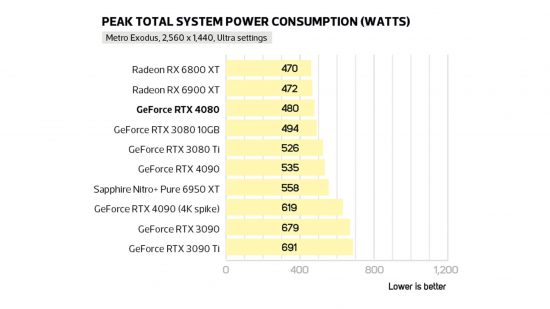
Next we come to DLSS 3, which still isn’t officially supported in Cyberpunk 2077 yet, but Nvidia has given us access to a preview build to test it with the new GPUs. DLSS 3 cleverly uses AI to generate extra frames to improve the frame rate and, aside from a few occasional artefacts, it works surprisingly well.
The RTX 4080 wasn’t far off the RTX 4090’s performance with DLSS 3 enabled, with a huge 104fps average at 4K and an 88fps 99th percentile. That’s a cracking result, and the game looks brilliant at these settings.
Thanks to its smaller, less complicated chip than the RTX 4090, the RTX 4080’s power efficiency isn’t terrible either. Our system drew 480W from the mains with the RTX 4080 installed, and this was consistent at all resolutions. Conversely, our system drew 535W with the RTX 4090 running at 2,560 x 1,440, but it then peaked at 619W at 4K. It’s still at the upper end of our power draw graphs, but it’s in the same sort of league as the Radeon RX 6800 XT and GeForce RTX 3080.
As with the RTX 4090, the 4080 also uses the new 16-pin power connector, with a 3 x 8-pin PCIe adaptor included in the box. There have been several reports of these plugs melting in some circumstances online, and while we haven’t seen this happen on any of our samples, we’ll be keeping an eye on it.
Meanwhile, the GPU temperature peaked at 63.8°C during benchmarking, with a 77°C hot spot reading. Comparatively, the RTX 4090 hit 67.5°C with a 77.6°C hot spot. The massive cooler is clearly doing its job well, and it never became irritatingly noisy during testing either.
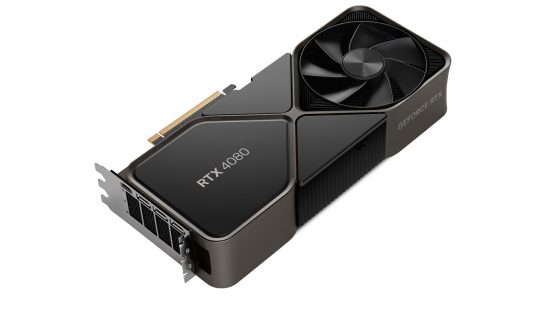
Nvidia GeForce RTX 4080 pros and cons
Pros
- Fantastic ray tracing performance
- Fantastic overall gaming performance
- DLSS 3 support
- Decent power efficiency
Cons
- Extremely expensive
- Seriously, the price is ridiculous
Nvidia GeForce RTX 4080 specs
The GeForce RTX 4080 specs list is:
| Stream processors / CUDA cores | 9,728 |
| RT cores | 76 (3rd-gen) |
| Tensor cores | 304 (4th-gen) |
| Base clock | 2205 MHz |
| Max boost clock | 2505 MHz |
| Memory | 16 GB GDDR6X |
| Memory clock | 1400 MHz (22.4 GHz effective) |
| Memory bandwidth | 716.8 GB/s |
| Memory interface | 256-bit |
| Card interface | 16x PCIe 4 |
| Power connectors | 1 x 16-pin / 3 x 8-pin |
GeForce RTX 4080 price
The Nvidia GeForce RTX 4080 price $1,199, making it a very expensive graphics card, especially when the price isn’t far below that of the much more powerful GeForce RTX 4090.
Price: Expect to pay $1,199 (£1,199)
GeForce RTX 4080 review conclusion
While the GeForce RTX 4080 is clearly an incredible piece of silicon engineering, it’s hard to get excited about a card that only a select few people will be able to afford in these times. That said, if you can afford to splash out, but can’t quite run to the cost of the RTX 4090, then the RTX 4080 is a superb card.
It only starts to (slightly) struggle when you pile on all the settings in very demanding games at 4K, but even then you can hit a perfectly acceptable compromise between graphics settings and frame rates. Its support for DLSS 3 will also be an enormous boon when more games officially support it.
However, we suggest holding fire for at least a month. AMD’s next-gen GPUs are due to launch in December, and the red team is planning to significantly undercut Nvidia when it comes to pricing. Let’s hope some healthy competition can smack the GPU business back down to earth. If the RTX 4080 is too expensive for your budget, check out our full guide to the best graphics card, where we detail several alternatives at a range of prices.
